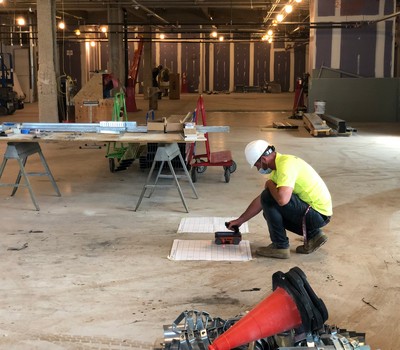RainierGPR Concrete Scanning: The Most Effective Option for Construction Specialists
RainierGPR Concrete Scanning: The Most Effective Option for Construction Specialists
Blog Article
Exploring the Key Benefits of Concrete Scanning in Building Projects
In the realm of modern construction techniques, the use of concrete scanning innovation has actually become an essential tool for making certain project performance and structural honesty. From boosting safety and security procedures to accurately detecting energies hidden under the surface, the advantages of concrete scanning are multifaceted. The capability to improve project timelines and minimize prices while protecting existing structures is a testimony to the worth this innovation offers the building industry. As we explore the nuanced advantages of concrete scanning, it ends up being obvious that its impact prolongs far past surface-level evaluations, supplying a look into the intricate internet of advantages waiting to be discovered.
Improved Safety Steps
Using advanced concrete scanning technology improves precaution on construction sites by supplying exact discovery of possible hazards hidden beneath the surface. This innovation allows building and construction groups to determine rebar, channels, post-tension cable televisions, and other obstructions before excavation or drilling, considerably decreasing the risk of accidents. By determining these components precisely, employees can stay clear of harmful critical architectural components, hence avoiding injuries, hold-ups, and costly fixings.
In addition, concrete scanning plays a crucial duty in guaranteeing the integrity of existing frameworks throughout expansions or renovations. By identifying weak points, voids, or damage within concrete aspects, engineers can address these concerns proactively, improving the total security and longevity of the structure. This positive method not just alleviates the risk of structural failings however additionally decreases the capacity for mishaps triggered by unexpected architectural deficiencies.
Fundamentally, the execution of concrete scanning innovation offers as a positive precaution that safeguards both building and construction workers and the architectural integrity of structures, ultimately adding to the total success and efficiency of building tasks. - RainierGPR Concrete Scanning
Accurate Detection of Energies
Concrete scanning technology assists in precise identification of underground energies, boosting building website safety and efficiency. Precise discovery of energies is crucial in building tasks to prevent expensive damages, job hold-ups, and most notably, ensure the security of employees and the general public. By making use of innovative scanning technologies such as ground-penetrating radar (GPR) and electromagnetic induction, construction teams can map out the location of buried pipelines, cable televisions, and other utilities with high degrees of accuracy.

Time and Price Performance

Concrete scanning modern technology enables building groups to properly locate rebar, post-tension cable televisions, and various other ingrained objects within concrete frameworks. This specific information helps in preventing expensive blunders such as accidental damage to essential elements during boring, reducing, or coring tasks. In addition, by identifying potential risks ahead of time, the demand for check these guys out expensive repairs or rework because of damages can be reduced, causing cost savings for the job.
In addition, the ability to swiftly and properly find utilities under the surface without causing any kind of damages not just conserves time yet also avoids expensive disruptions to existing infrastructure. In general, the time and cost performance advantages of concrete scanning make it an indispensable tool for improving construction project monitoring and implementation.
Conservation of Structural Integrity
Maintaining the architectural honesty of buildings and infrastructure is vital in making sure long-lasting security and safety and security. Concrete scanning plays a vital duty in this preservation procedure by enabling building professionals to recognize prospective hazards to the architectural stability of a structure or framework before they rise find more information into significant problems. With making use of innovative scanning technologies such as ground-penetrating radar (GPR) and electromagnetic induction, building and construction groups can non-invasively analyze the problem of concrete frameworks, find rebar, post-tension wires, and other ingrained components, and determine any spaces, cracks, or damage within the concrete.
Improved Job Preparation
In order to guarantee the successful execution of construction tasks, thorough interest to detail and complete preparation are necessary elements that stem from an extensive understanding of the structural problems determined with concrete scanning. Ultimately, including concrete scanning right into the job planning stage boosts sychronisation among group members, fosters aggressive problem-solving, and contributes to the effective shipment of construction tasks within budget plan and schedule restraints.
Final Thought
To conclude, concrete scanning provides countless benefits in construction tasks. By enhancing safety and security procedures, accurately identifying energies, improving time and price efficiency, protecting structural stability, and aiding in job preparation, concrete scanning verifies to be a vital device for successful task execution. Its capacity to minimize dangers, increase effectiveness, and guarantee task integrity makes it an essential property for building and construction experts.
In the realm of modern construction practices, the usage of concrete scanning innovation has actually emerged as a pivotal tool for guaranteeing task effectiveness and architectural stability.Concrete scanning innovation enables building groups to accurately find rebar, post-tension cords, and various other embedded items within concrete structures. Via the usage of advanced scanning technologies such as ground-penetrating radar (GPR) and electromagnetic induction, building groups can non-invasively examine the problem of concrete structures, find rebar, post-tension cords, and various other ingrained components, and identify any type of spaces, fractures, or damage within navigate to this website the concrete.
In order to guarantee the successful implementation of construction projects, precise interest to detail and complete preparation are necessary parts that stem from a thorough understanding of the architectural problems determined with concrete scanning. Ultimately, integrating concrete scanning into the project planning stage boosts control amongst team members, cultivates aggressive analytical, and contributes to the successful delivery of construction tasks within spending plan and routine restrictions.
Report this page